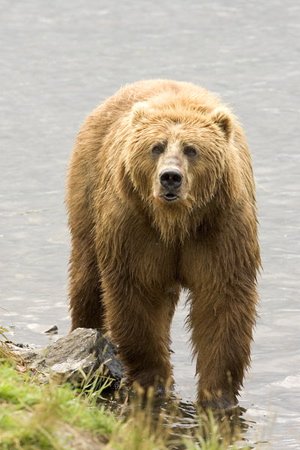On the Origins of New Forms of Life
9.9: Terrestrial Predators
EUGENE M. MCCARTHY, PHD GENETICS
|
|
(Continued from the previous page)

|
When a biologist thinks of mammalian terrestrial predators, the tendency is to think of the members of Order Carnivora. Nevertheless, animals that regularly kill and eat other animals occur in several other mammalian orders. Although various writers suggest insectivores are more "generalized" than other mammals, they are nevertheless predators of a sort, and thus are suited to a certain way of life. It seems likely that many insectivores feed on insects only because they themselves are small. Young crocodiles catch and eat insects, but prey on antelope when they are older. Small carnivores such as coyotes, foxes, mongooses, civets, and kinkajous eat both insects and small vertebrates. Insects can be a staple even in the diet of large “carnivores.” Termites and other insects are the primary food of the sloth bear (Ursus ursinus), an animal that sometimes weighs more than 300 pounds. In the present discussion the insectivores will therefore be grouped together with the carnivores of Order Carnivora as predators.
Insects and meat are important not only for the predators just mentioned, but also for most primates. Many primates actually are predators. While it is true that there are certain largely herbivorous and/or frugivorous primates (e.g., gorillas, langurs, many of the lemurs), meat and insects are important in the diet of many primates. On the other hand, certain forms categorized as carnivores seem unworthy of the name. The panda is so classified, yet it consumes bamboo almost exclusively. Vegetable matter makes up 96 percent of diet of the South American spectacled bear (Tremarctos), another member of order Carnivora. The diet of Blanford's fox (Vulpes cana) consists largely of fruit. Like most bears, the chimpanzee subsists primarily on vegetable matter, but will eat meat whenever possible. Many other primates rely heavily on both meat and insects. Moreover, certain primates are physically similar to certain procyonid carnivores. For example, the night monkeys (genus Aotus) are similar to the Kinkajou (Potos flavus) and the olingos (genus Bassaricyon). Like most terrestrial predators, primates have bifocal vision that allows a fine judgment to be made of the distance to the prey, and large canines with which to bite it. It seems reasonable, then, to think of the typical primate as an arboreal variation on the general predator theme.
We have every reason to think mammalian terrestrial predators are much older than orthodox theory suggests. Viverrid carnivores, for example, must have existed quite early because viverrids, such as civets and mongooses, exist today in Madagascar, and also existed elsewhere—viverrids are also known from the Eocene of Europe. Since Madagascar has been isolated from other landmasses at least since the late Jurassic (about 150 mya), these facts suggest forms similar to modern viverrids existed already in early Jurassic times. Likewise, the presence in modern Madagascar of a peculiar nocturnal, catlike predator with retractable claws, the Fossa (Cryptoprocta), suggests that cats had already begun to evolve by the early Jurassic (otherwise the cats known from other landmasses than Madagascar, would have come into being independently of, and be unrelated to, the fossa). Among mammalian types, terrestrial predators are among the easiest to link with the synapsids. In fact, orthodox theory derives not only carnivores, but also all other mammals from a particular group of predatory synapsids, the cynodonts, known from Permian and Triassic fossils. While it seems implausible to derive such types as whales, bats, and ungulates from the dog- or bearlike cynodonts (“cynodont” means “dogtooth”), it does appear many of the later predators accepted as mammals (e.g., Morganucodon and Sinoconodon of late Triassic and Jurassic; Amphilestes and the triconodonts of the Jurassic and Cretaceous; the numerous known predators of the Tertiary) can reasonably trace their roots to the cynodonts. Although the cynodonts are considered “mammallike reptiles” (synapsids), their bones and teeth are more like those of modern mammals (in particular those of modern predatory mammals) than are those of any modern reptile.
9.9: Terrestrial Predators - © Macroevolution.net
8.1: Dubious Assumptions - © Macroevolution.net